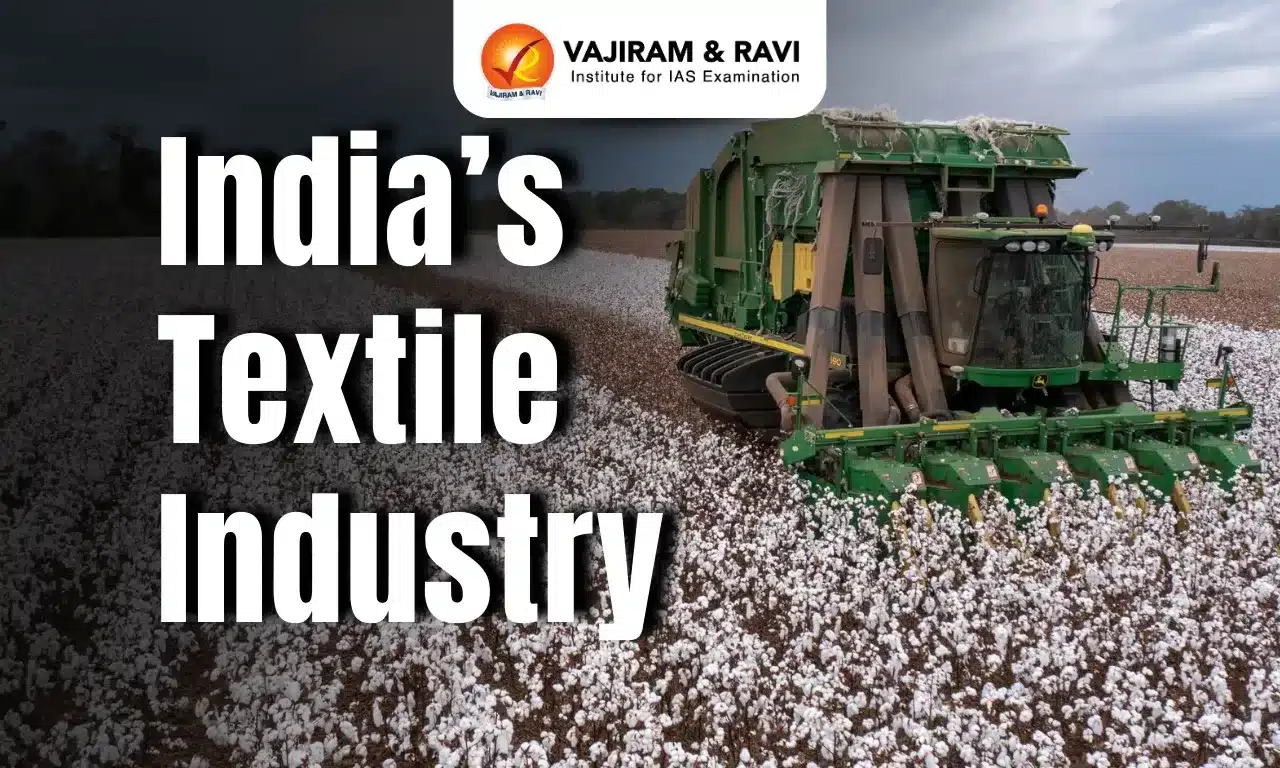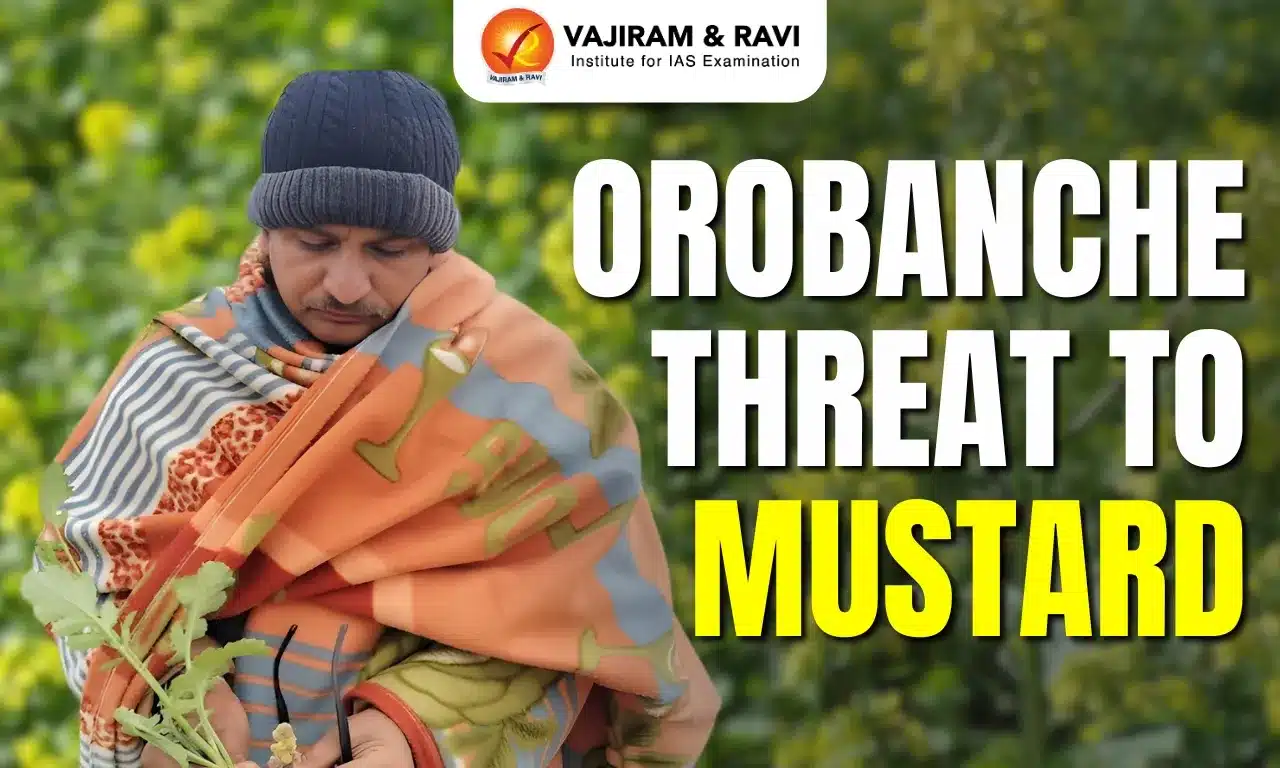What’s in Today’s Article?
- India’s Textile Industry Latest News
- India’s Textile Journey: From Fibre to Fabric
- India’s Textile and Apparel Industry: Growth and Export Trends
- India’s Textile Export Challenges
- The Sustainability Challenge in India’s Textile Industry
- India’s Textile Industry FAQs
India’s Textile Industry Latest News
- India’s textile industry is one of the largest globally, covering the entire value chain from cotton cultivation to apparel manufacturing. However, it lags behind China, Vietnam, and Bangladesh in exports due to fragmented supply chains, higher costs, and complex regulations.
- Despite being a major producer of cotton and synthetic fibres, the industry has seen slow growth. Rising sustainability and compliance requirements are expected to further increase costs, particularly for smaller firms.
India’s Textile Journey: From Fibre to Fabric
- Cotton Production and Employment
- India is the second-largest cotton producer globally, contributing 24% of global production.
- Cotton farming involves around 60 lakh farmers, primarily in Gujarat, Maharashtra, and Telangana.
- The cotton textile value chain, from fibre processing to garment manufacturing, employs over 4.5 crore people.
- Man-Made Fibre (MMF) Industry
- India is also the second-largest producer of MMF, with Reliance Industries leading in polyester and Grasim Industries being the sole domestic producer of viscose.
- However, MMF consumption in India remains low at 3.1 kg per capita, compared to 12 kg in China and 22.5 kg in North America.
- Overall fibre consumption, including natural and synthetic fibres, is 5.5 kg per capita, below the global average of 11.2 kg.
- MSME Clusters and Specialisations
- Around 80% of India’s textile value chain operates within MSME clusters, each specializing in different textiles:
- Bhiwandi (Maharashtra) – Fabric production
- Tiruppur (Tamil Nadu) – T-shirts and undergarments
- Surat (Gujarat) – Polyester and nylon fabrics
- Ludhiana (Punjab) – Woolen garments
- Around 80% of India’s textile value chain operates within MSME clusters, each specializing in different textiles:
India’s Textile and Apparel Industry: Growth and Export Trends
- India’s textile and apparel sector is a key economic driver, contributing 13% to industrial production, 12% to exports, and 2% to GDP.
- However, manufacturing growth has slowed over the past decade.
Growth Trends
- Between FY15 and FY19, the textile sector grew at a CAGR of 0.4%, while apparel grew at 7.7%.
- From FY20 to FY24, the industry contracted, with textiles shrinking by 1.8% annually and apparel by 8.2%, largely due to post-pandemic economic challenges.
Export Performance and Key Markets
- Despite a trade surplus, textile and apparel exports have seen sluggish growth.
- In FY24, exports stood at $34.1 billion, slightly up from $33.4 billion in FY20.
- Nearly 50% of exports were to the U.S. and EU, serving brands like JCPenney, Gap, and Decathlon.
Sector-Wise Export Trends
- Garment and Apparel Exports – Declined from $15.5 billion in FY20 to $14.5 billion in FY24.
- Cotton Textiles and Home Textiles – Grew from $10.2 billion in FY20 to $12.3 billion in FY24, with key players like Welspun Living and Trident Ltd.
Challenges for MSMEs
- The slowdown has hit MSME clusters, especially in Tamil Nadu, due to global and domestic economic headwinds, impacting production and exports.
India’s Textile Export Challenges
- Lagging Behind Competitors
- India trails China, Vietnam, and Bangladesh in textile exports due to higher production costs and a fragmented supply chain.
- In contrast, Vietnam exported $40 billion worth of apparel in 2023, benefiting from vertically integrated supply chains that lower manufacturing costs.
- Fragmented Cotton Supply Chain
- India’s cotton supply chain is spread across multiple states, increasing logistical costs and hindering large-scale production.
- The lack of localisation makes production costlier compared to fibre-to-fashion firms in China and Vietnam, which offer low-cost, high-quality, and adaptable exports.
- Regulatory and Trade Barriers
- Competitor nations benefit from free trade agreements (FTAs) and simpler customs procedures, reducing regulatory costs.
- In contrast, India’s complex export procedures, requiring detailed accounting of every fabric, button, and zipper, increase compliance burdens for exporters.
- High Raw Material Costs in MMF Sector
- India’s man-made fibre (MMF) sector suffers from high raw material costs.
- Quality control orders (QCOs) restrict imports of polyester and viscose fibres, forcing domestic yarn makers to rely on costlier local alternatives.
The Sustainability Challenge in India’s Textile Industry
- Growing Global Focus on Sustainability
- With global markets tightening compliance norms, Indian manufacturers must increase renewable energy use, improve recycling, and ensure stricter sourcing and traceability.
- Rising Costs Due to Sustainable Sourcing
- A global shift towards sustainable textiles is increasing production costs.
- The EU, which accounts for 20% of India’s textile exports, has implemented 16 new regulations from 2021 to 2024, making it challenging for small enterprises to transition to environmentally friendly production.
- The Fast Fashion Waste Crisis
- The textile recycling market in India is projected to reach $400 million, while the global market could touch $7.5 billion.
- With fashion waste expected to hit 148 million tonnes by 2030, PM Modi highlighted the need for higher recycling efforts, as currently, less than 25% of textile waste is recycled.
India’s Textile Industry FAQs
Q1. Which state is famous for the textile industry in India?
Ans. Gujarat, Maharashtra, and Tamil Nadu are India’s top textile hubs, with Surat, Mumbai, and Tiruppur being key manufacturing centers.
Q2. What are man-made fibres?
Ans. Man-made fibres (MMF) are synthetic or regenerated fibres, such as polyester, viscose, and nylon, produced using chemical processes.
Q3. What are 5 synthetic fibres?
Ans. Five common synthetic fibres are polyester, nylon, acrylic, spandex, and polypropylene, widely used in textiles and apparel.
Q4. What is called cotton?
Ans. Cotton is a natural fibre from the cotton plant, known for its softness, breathability, and widespread use in textiles.
Q5. Where is cotton grown in India?
Ans. Cotton is primarily grown in Gujarat, Maharashtra, Telangana, Rajasthan, and Madhya Pradesh, covering major cotton-producing regions.
Last updated on January, 2026
→ Check out the latest UPSC Syllabus 2026 here.
→ Join Vajiram & Ravi’s Interview Guidance Programme for expert help to crack your final UPSC stage.
→ UPSC Mains Result 2025 is now out.
→ UPSC Notification 2026 is scheduled to be released on January 14, 2026.
→ UPSC Calendar 2026 has been released.
→ UPSC Prelims 2026 will be conducted on 24th May, 2026 & UPSC Mains 2026 will be conducted on 21st August 2026.
→ The UPSC Selection Process is of 3 stages-Prelims, Mains and Interview.
→ Prepare effectively with Vajiram & Ravi’s UPSC Prelims Test Series 2026 featuring full-length mock tests, detailed solutions, and performance analysis.
→ Enroll in Vajiram & Ravi’s UPSC Mains Test Series 2026 for structured answer writing practice, expert evaluation, and exam-oriented feedback.
→ Join Vajiram & Ravi’s Best UPSC Mentorship Program for personalized guidance, strategy planning, and one-to-one support from experienced mentors.
→ UPSC Result 2024 is released with latest UPSC Marksheet 2024. Check Now!
→ UPSC Toppers List 2024 is released now. Shakti Dubey is UPSC AIR 1 2024 Topper.
→ Also check Best UPSC Coaching in India

















